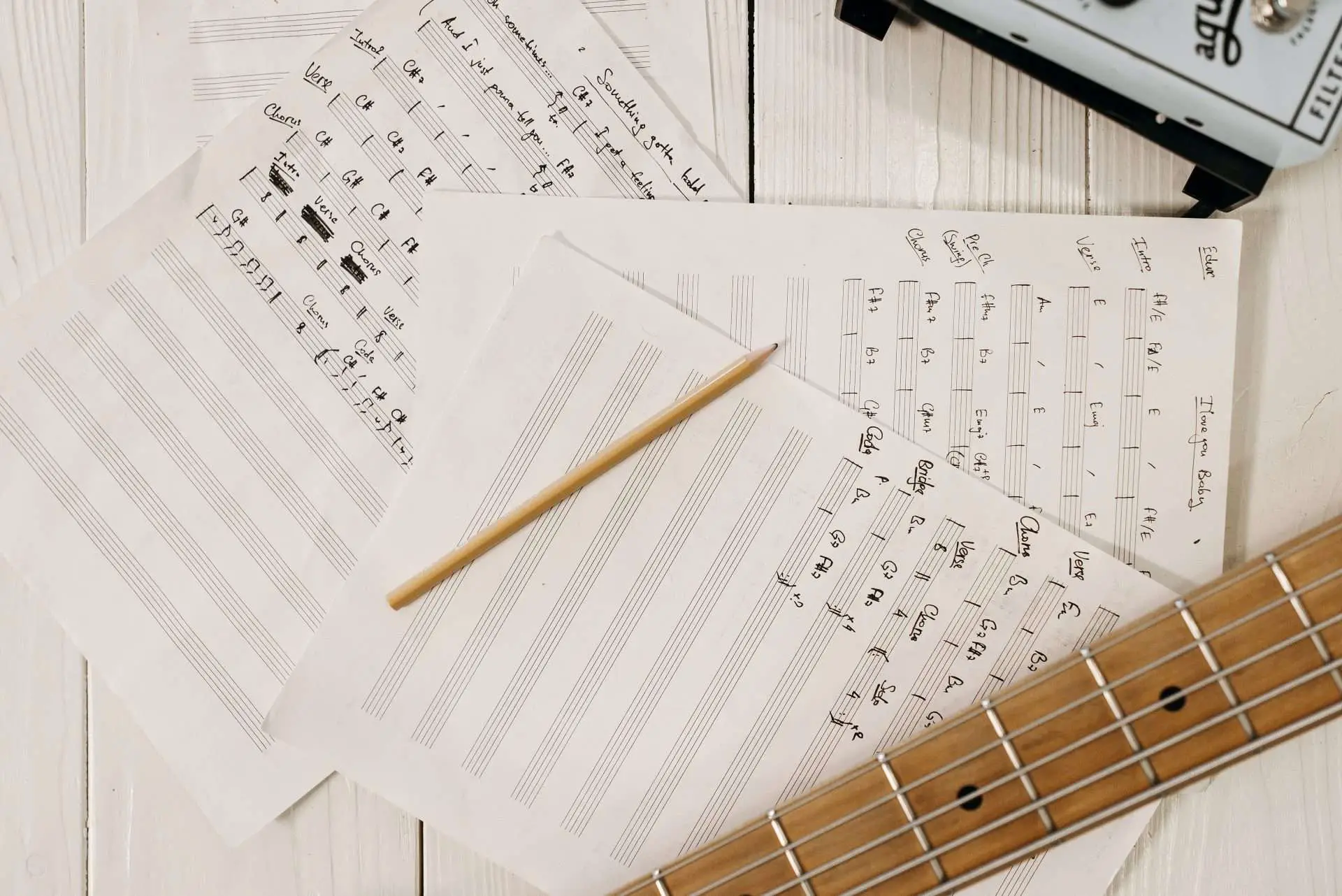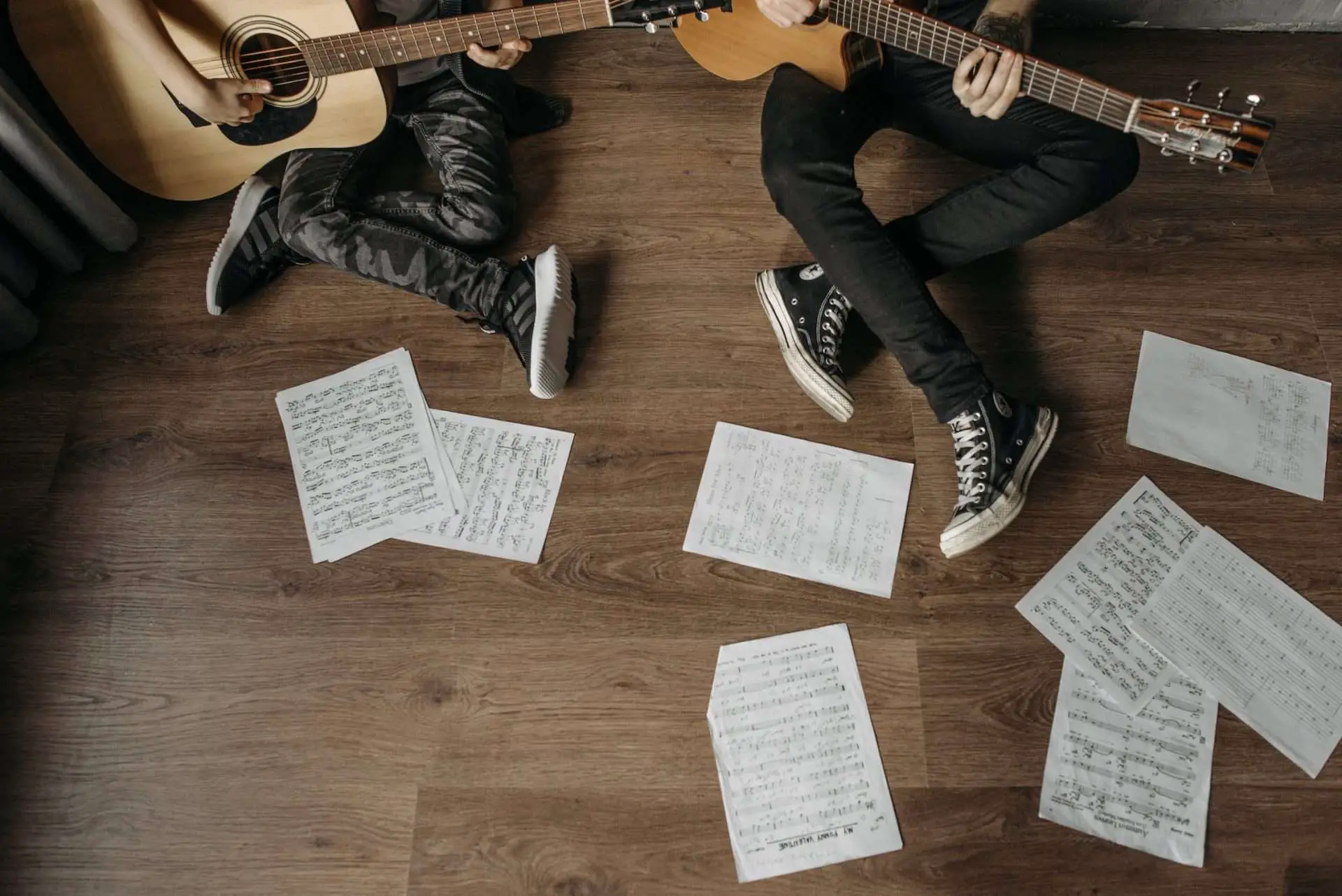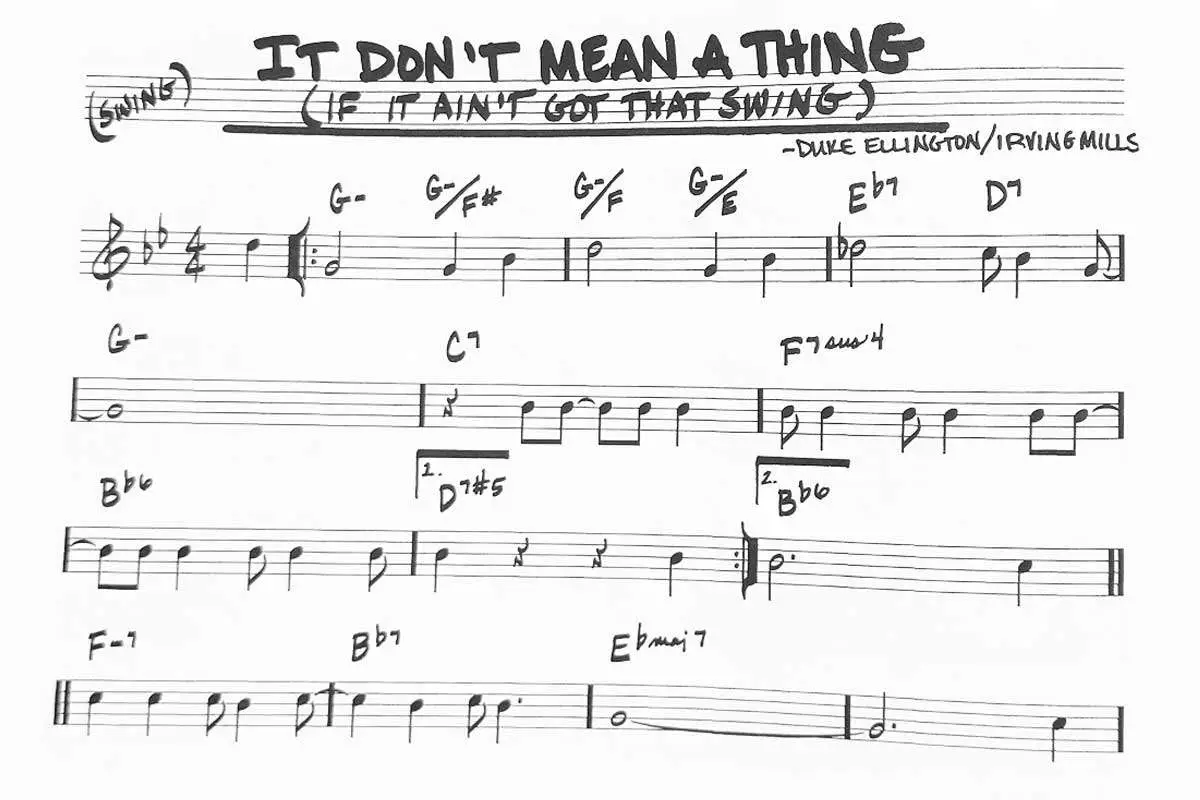Lead sheet symbols (or lead sheet chord symbols) are the primary musical notation of Jazz and pop music. Knowing how to read and write lead sheet symbols has many benefits such as learning popular jazz tunes, gigging with other musicians, and best of all, composing your own music!
This article will teach you about the elements that make up a lead sheet, how to read chord symbols, and give you tips for writing perfect lead sheets every time!

Elements of Lead Sheet Symbols
Every lead sheet can be broken up into 3 parts: The staff, the chords, and other markings. Let’s look closer at each element of the lead sheet.
The Staff
Every lead sheet comes with a staff. The staff usually only includes the main melody of the song. This melody is usually sung or played by horns such as trumpet or saxophone.
In addition to that, the staff also includes the musical clef, the key signature, and a time signature. Repeats and alternate endings are very common elements in these lead sheets as well. The musical staff is very similar to that of classical music, and so if you can read sheet music those skills will transfer over to reading lead sheets.
The Chord Symbols
Next is arguably the most distinctive factor of lead sheets – the chord symbols. At first glance these symbols can seem vague and esoteric, but once you learn the simple system behind their notation, they become intuitive and effortless.
The chord symbols hover just above the musical staff, and they represent the harmonic changes that accompany the melody. As I said before, the guitar and piano are typically the instruments that carry the responsibility of playing these chords. Sometimes, but not often, the symbol will have a small chord chart showing how to play the chord.
The majority of this article will go into how to read these chord symbols, but we will get to that a bit later.
Lyrics
Lyrics are often printed below the staff, this is for tunes that are intended to be sung, so not all lead sheets will include them!
Other Markings
While the staff and chord symbols are the most important parts of your lead sheet, there are the odd markings here and there you may be wondering about.
Tempo markings are usually placed at the upper left hand corner of the page. These markings describe the overall feel, energy, emotion, or genre of the tune. Common tempo markings include: Ballad, Med, swing, Bop, Bossa etc…
Many jazz tunes are split up into sections, the sections are typically marked with letters such as A, B, C. Oftentimes certain sections are repeated and every musician takes turns soloing over it.
At the bottom right of your lead sheet, you might see a note from the publisher, telling about the form of the tune and how it should be played. A couple examples of this may be “solos on entire form” or “D.C. AL after solos” (that’s another way of saying back to the top after everyone has soloed)

How To Read Chord Symbols
Chord symbols are a letter based system of chord notation that provide a harmonic accompaniment to go along with the melody. Guitarists and pianists are usually the rhythm instruments, so knowing how to read the chord symbols is so important for them. If you buy fake books, or song books, you have most likely come across these symbols.
There are a few universal rules for writing these symbols:
- Chord symbols are written above the staff.
- Chord symbols use uppercase letters to represent the root of the chord.
- The chord symbols don’t always belong to the given key – accidentals need to be specified!
- There is no standardized way of writing lead sheets, so many alternatives need to be memorized.
Triads
If you see a letter by itself, that means that it is a major triad.
Example: C = CEG
If you see a letter with a lowercase m, -, or min, that means it is a minor triad.
Example: Cm, C-, Cmin = C Eb G
If the letter is followed by ° or dim, that means the chord is diminished.
Example: C°, Cdim = C Eb Gb
If the letter is followed by +, the chord is augmented.
Example: C+ = C E G# (not the programming language lol)
7th Chords
If the letter is followed by a Maj 7, Δ7, or M7, the chord is a major 7 chord.
Example: CMaj7, CΔ7, CM7 = CEGB
If the letter is followed by a min 7, m7, or -7, the chord is of minor 7 quality.
Example: Cmin7, Cm7, C-7 = C Eb G Bb
If the letter is followed by a 7, the chord is of dominant quality.
Example: C7 = C E G Bb
If the letter is followed by m7b5, the letter is of half diminished quality.
Example: Cm7b5 = C Eb Gb Bb
Lastly, if the letter is followed by “°7” then the chord is of fully diminished quality.
Example: C Eb Gb Bbb
Check out our post: Easy Intro To 7th Chords On Guitar
Extended Chords
Jazz chords famously implement advanced chords such as 9th, 11th, and 13th and their altered variants.
The number that follows the letter indicates the additional notes that should be played.
Example: C7b9 = C E G Bb Db
Example 2: Ebmaj7#11 = Eb G B D A
Example 3: F9 = F A C Eb G
Sus Chords
Sus chords are the common vernacular for what are called “suspended chords”. These chords are pretty straightforward.
When the letter is followed by sus 4 or sus2, that means suspended 4 or suspended 2. For example in the Gsus guitar chords (Gsus2 & Gsus4)..
Example: Csus4 = C F G
Example 2: E7sus4 = E A B D
Slash Chords
Last but not least, slash chords! Slash chords are chord symbols indicating inversions.
When the letter has a slash followed by an additional letter, this is telling us to play the chord in a particular inversion.
Example: C/E = C major with E in the bass (aka 1st inversion)
Example 2: Eb/G = Eb major with G in the bass (aka Eb major 1st inversion)
Example 3: E-7/D = E minor 7 with D in the bass (aka E-7 3rd inversion)
The last thing that you should know is that sometimes the given bass note is not even a chord tone!

Tips For Writing Your Own Lead Sheets
Maybe you have a musical idea that you want to share with a group, or maybe you simply want to dedicate some of your compositions to paper. As you gain more experience reading and playing with lead sheets, the idea of writing them becomes all the more tempting. Here are some tips for making sure your lead sheets are top notch!
- Keep your lead sheets concise and easy to read. Less is more!
- Make sure all elements of the lead sheet are present. Lead sheets should include your melody, chord changes, lyrics, and additional markings like key signature, time signature, and tempo.
- Sections should be marked, the best place to separate your sections is at the beginning of a line so it is easily recognizable. Section markings can be letters, but they can also be named. (Intro, verse, chorus, etc)
- Put 4 bars per line.
- Avoid repetition. Repeats should be marked with a repeat symbol. Writing out repeats is an easy way to add more content to your page than you intended.

Frequently Asked Questions
What is a lead sheet symbol?
A lead sheet symbol is a simple and condensed way of notating a song’s structure and feel.
Lead sheets avoid putting too much information on the page because this makes it confusing for the musicians who often sight reading.
Additionally, this allows the players to express themselves more freely by having them rely more on improvisation than the sheet music.
What does ∆ mean in music?
In music, a triangle, or delta symbol, means major 7. I really do not know why, I used to think because a triangle has 3 points that it meant “triad” but the Δ symbol is non even used to denote a triad.
What is the purpose of a lead sheet?
The purpose of a lead sheet is to give gigging musicians a quick and simple layout of a tune that can be sightread. Lead sheets are clear and straightforward and are only meant to deliver the basis of a tune – not fine details such as standard notation.
Related: How To Read Chord Progressions
How do you write a good lead sheet?
The best ways to write a good lead sheet are: keep it simple, keep it organized, mark your sections, and keep it on one page if possible.
